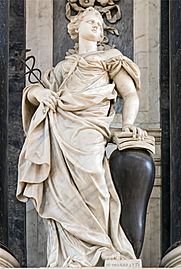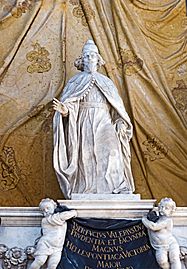Pietro Baratta facts for kids
Pietro Baratta (born 1659, died 1729) was a talented Italian sculptor from the Baroque period. He worked mainly in the city of Venice. He was known for his beautiful sculptures, and he even taught other sculptors, like Francesco Robba.
Biography
Pietro Baratta was born in Carrara, a town in Tuscany, Italy, famous for its marble. He spent most of his working life in Venice and Udine. He also created sculptures for villas (large country houses) on the mainland and helped design gardens.
Pietro came from a family of artists. His uncle, Francesco Baratta the elder, was also a sculptor who worked with the famous artist Bernini in Rome. Pietro's two brothers, Francesco and Giovanni, were sculptors too!
Pietro Baratta had his own busy art studio. Many young artists, including Francesco Robba, learned their skills there. Pietro also received many requests for his art from other countries. For example, he and his team made many sculptures for the beautiful St. Petersburg gardens in Russia. Some of these sculptures are still there today, like "Andromeda," an "Allegory of Architecture," and busts (sculptures of heads and shoulders) like the "Allegory of Winter" and "Allegory of Spring."
Works
Pietro Baratta created many important sculptures.
He made the sculptures for the front of the chapel at Villa Manin in Passariano di Codroipo, near Udine. These include statues of the four Evangelists (writers of the Gospels in the Bible) and a statue of the Madonna (Mary) with the Child.
Pietro Baratta likely also made five statues for the front of the Church of Santa Maria at Villa Vicentina. These statues show Saint Roch, Saint Antony Abbot, the Blessed Virgin of the Rosary, Saint Matthew, and Saint John Baptist. This church was built between 1660 and 1680.
He also created the statue of Saint Ignatius of Loyola for the church of Santa Maria Assunta (I Gesuiti) in Venice. This statue shows Saint Ignatius thinking deeply, holding an open Bible in his hands.
See also
 In Spanish: Pietro Baratta para niños
In Spanish: Pietro Baratta para niños



